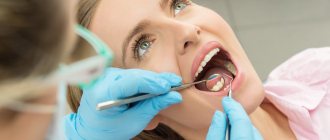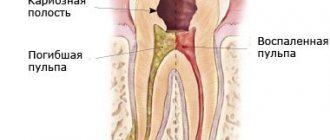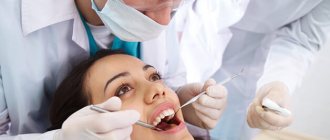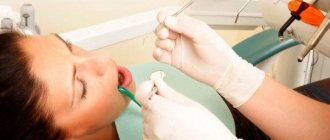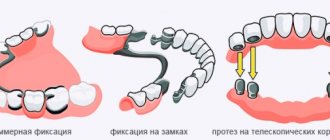Author of the article:
Soldatova Lyudmila Nikolaevna
Candidate of Medical Sciences, Professor of the Department of Clinical Dentistry of the St. Petersburg Medical and Social Institute, Chief Physician of the Alfa-Dent Dental Clinic, St. Petersburg
Let's figure out how to determine that gum inflammation has begun after tooth extraction, how to quickly get rid of it and prevent its occurrence.
Signs of normal wound healing
After a tooth is removed, a hole is formed in the empty area in which a natural blood clot accumulates. It is very important to monitor it closely. This substance must not be removed, scrubbed, washed or dissolved. A blood clot is the most reliable protection of a wound from infection and inflammation.
Gum restoration begins 3-4 days after tooth extraction. If the operation was traumatic, the healing process lasts 5-7 days. After removal of wisdom teeth (“eights”), the healing process can exceed 10 days. The back teeth are the most “complex”, as they have many canals, so after their removal the risk of gum inflammation is especially high.
Within 5-7 days after tooth extraction, a white film appears at the bottom of the empty socket. This film is an absolutely normal reaction of the body, as protective fibrin covers the wound from “attacks” of pathogenic organisms. Just like a blood clot, the film should never be processed.
The speed of healing of the hole depends on a number of factors:
- depth of the operation performed;
- localization of the focus of the operation;
- associated dental problems;
- the state of immunity and other characteristics of the patient’s body.
If the gums are swollen and begin to bleed within half an hour to an hour after tooth extraction, this is normal. However, if the inflammation does not subside within a few hours, be sure to contact your surgeon.
Wisdom tooth removal
Wisdom teeth are considered full-fledged elements of the oral cavity. They are involved in chewing food (if they are located above each other and have contact), and can act as a support for bridges and removable dentures in the future. There are specific indications for extraction in their case. For this reason, the decision about whether wisdom teeth need to be removed is made only by the attending physician.
The most common problem with eighth teeth is their growth. Only some teeth form and grow completely without complications, but often these processes are accompanied by a number of difficulties:
- semi-retinated or impacted elements that have formed in the bone tissue, but have not erupted or only partially erupted. Their position can be vertical, horizontal, or with their roots outward. Because of this, neighboring elements suffer, constant pain appears;
- violation of position (dystopia). Since wisdom teeth erupt without predecessors (baby teeth), and the jaw bone is already formed and does not develop, the position of the elements is often incorrect. They injure the mucous membrane, overlap other crowns, and put pressure on neighbors. This leads to inflammation. The doctor will determine whether the position can be restored with orthodontic treatment or whether it is better to remove the wisdom tooth;
- appearance of a gingival hood. When slowly cutting through the mucosa, an area is formed in which bacteria and food debris accumulate, which are difficult to clean. This leads to acute inflammation, which can provoke the appearance of pus;
- destruction, caries. Elements may appear immediately underdeveloped with carious lesions.
The doctor determines whether wisdom teeth should be removed or not based on complaints and the clinical picture. Problems with even one or two teeth interfere with the normal functioning of the entire dental system. Pain appears when opening the mouth and chewing. The bite and position of the incisors may even change.
How a wisdom tooth is removed depends, as in the case of permanent elements, on the condition of the dental system. In the absence of contraindications, manipulation is carried out with ordinary forceps.
Whether it is painful to remove a wisdom tooth depends on the presence or absence of purulent formations. If they are present, then the painful sensations may persist even after pain relief. Most often, classical infiltration anesthesia is used, which covers a large area and maintains the effect for a long time.
Types of inflammation
The most common types of inflammation that occur after tooth extraction are:
- Alveolitis is an inflammation of the walls of the empty socket of an extracted tooth. The patient suffers from swelling, redness, and “tugging” pain. Weakness, malaise appear, and body temperature rises.
- Gingivitis is inflammation caused by tooth extraction. The tissues turn red, begin to swell and bleed.
- Periostitis is an inflammation of the jaw bone (periosteum). The disease is characterized by severe toothache, swelling of the gums, gumboil, and distortion of the facial contour. Pathological mobility of the tooth appears, lymph nodes are palpated in the face and neck.
- Periodontitis is inflammation of the periodontium, the area around the root of the tooth. The disease is characterized by aching or sharp pain in the tooth, which intensifies when biting. Without treatment, the pain gradually turns into throbbing, tearing pain. The patient complains of severe weakness, fever, and sleep disturbances.
- Trauma to the gums from dental fragments. With mechanical damage to tissues, swelling, redness appear, and spontaneous pain begins, intensifying when touched. If the injury persists for a long time, a dark pressure ulcer with purulent and serous discharge may form at the site of injury.
Causes of the disease
Traumatic tooth extraction.
Alveolitis is often caused by a traumatic dental procedure. Injury can occur if a tooth is removed in fragments (parts). During the operation, sometimes the gums are damaged or the bone walls of the socket are partially destroyed. In this case, healing takes longer compared to uncomplicated removal and is often accompanied by the appearance of alveolitis.
Foreign particles entering the hole.
Sometimes pain after tooth extraction occurs as a result of the contents of the carious cavity, dental plaque, fragments of the extracted tooth, or bone fragments of the alveoli entering the socket. In addition, the cause of pain and alveolitis can be the destruction of a blood clot.
Failure to maintain socket hygiene.
Healing of the alveoli occurs due to the formation of a blood clot. This biological barrier protects the socket from infections and inflammation. After some time, the clot is replaced by newly formed bone tissue. It is not recommended to eat rough, hot or spicy foods within 24 hours after a dental procedure, as this can destroy the blood clot. In addition, brush your teeth and rinse your mouth with caution. Failure to follow the dentist's recommendations can lead to blood clot disruption, alveolitis and pain after tooth extraction.
Presence of infection.
Sometimes the cause of dental surgery is chronic periodontitis - inflammation of the tissues that surround the root. If you have had a tooth removed and its socket hurts, this may be caused by an infection getting into it.
Up to contents
Symptoms of inflammation
Inflammation of the gums after tooth extraction is indicated by the following symptoms:
- Bleeding from the wound. Even cold compresses do not stop the bleeding.
- Redness, swelling, pain in the gums that does not subside within 5-7 days after extraction.
- Throbbing sharp pain in the empty socket.
- Unpleasant putrid odor from the mouth.
- Discharge of pus from the wound, the resulting fibrous film becomes green.
- Numbness of the jaw, cheeks.
Treatment of inflammation
Treatment of gum inflammation after tooth extraction depends on the disease that arose during the operation. If a problem is suspected, the patient is advised to consult a doctor. An experienced dentist will determine the nature of the inflammation and prescribe proper treatment.
- In case of alveolitis, tissue curettage is performed, all contents are scraped out of the hole, and the tissues are sanitized. The doctor places a swab with an antiseptic on the wound.
- Periostitis is usually treated surgically. The doctor opens the rotting lesions and carries out medical treatment using anti-inflammatory, painkillers and antibiotics.
- Gingivitis requires the removal of tartar, normalization of oral hygiene and gum care using special rinses.
- For periodontitis, complex treatment is carried out using antibiotics, antiseptics, as well as anti-inflammatory and painkillers.
- Broken tooth fragments are removed by a surgeon; rinses, applications, and baths with antiseptics can be used to relieve inflammation.
Sometimes, for inflammation of the gums after tooth extraction, the patient is prescribed physiotherapeutic procedures, for example, exposure to a helium-neon laser, a course of fluctuarization. Also, gums can become inflamed after brushing your teeth.
With proper treatment of gum inflammation after tooth extraction, the socket is restored in about 10 days, and the outbreak itself disappears within two weeks.
Healing of the extracted tooth socket
METROGYL DENTA® is used for complex treatment and prevention of post-extraction alveolitis (inflammation of the socket after tooth extraction). The use of the drug helps eliminate inflammation by suppressing the activity of pathogens inhabiting the oral cavity. To prevent post-extraction alveolitis, the tooth socket after extraction is treated with METROGIL DENTA® gel and then the drug is applied for 7-10 days 2-3 times a day. METROGYL DENTA® has a good safety profile and is suitable for the treatment of periodontal diseases and mucous membranes of the cavity, starting from the age of 18.
Up to contents
The information in this article is for reference only and does not replace professional advice from a doctor. To make a diagnosis and prescribe treatment, consult a qualified specialist.
First aid
If after tooth extraction there is mild inflammation and there is no suppuration, it can be removed at home and prevent the spread of discomfort.
- For 30 minutes after tooth extraction, do not remove the antiseptic tampon placed in the hole.
- Do not eat for 2 hours after removal.
- If there is bleeding after tooth extraction, apply a cold compress, such as an ice cube, to the gum.
If a doctor prescribes rinses for the treatment of inflamed gums, they should be done as carefully as possible. It is important not to wash the protective clot out of the hole. On the first day after surgery, you should avoid rinsing, and on the second day, use antiseptics and herbal decoctions.
During the healing period, it is also recommended to avoid food and drinks that are too cold or too hot, and never touch the socket with your fingers, toothpicks or other foreign objects.
A reliable rinse that will help eliminate gum inflammation is the ASEPTA ACTIVE mouth rinse. This unique two-component rinse with a combination of chlorhexidine + benzidamine has antimicrobial, anti-inflammatory and analgesic effects and provides an immediate anesthetic effect.
COMPLICATIONS AFTER TOOTH EXTRACTION: HOW AND WHY?
After tooth extraction, your gums become inflamed, your jaw hurts, swelling appears, your cheek is swollen, your temperature rises? These are all the complications that arise after tooth extraction. Some of them go away on their own, but others require immediate medical intervention. Why do they appear, how to deal with them and when should you really worry? Tooth extraction is a difficult operation that traumatizes the tissue surrounding the tooth. Therefore, it is not surprising that unpleasant consequences occur after tooth extraction: the most common of them is swelling. Patients often complain that after tooth extraction, the gums become swollen, swelling of the cheek or a slight gumboil appears. This is caused by partial destruction of the soft tissue around the tooth. This is unpleasant, but if the tumor is small, it goes away on its own in 2-3 days. To relieve swelling after tooth extraction, ice can be applied to the cheek for about 10 minutes. If the swelling has not gone away after a day, apply heat. Keep the heating pad for 20 minutes, then take a break for 10 minutes and put the heating pad back on. Sometimes swelling can be caused by an allergy to the anesthesia. In this case, histamine, an antiallergic drug, will help. But if the swelling increases, then it may be a sign of inflammation that has arisen after tooth extraction. In this case, you should immediately consult a doctor. Temperature after tooth extraction. An increase in temperature is a normal reaction of the body to traumatic tooth extraction. It can last for 2 - 3 days, increasing in the evening. Maintain prescribed hygiene and take antipyretic medications. But if the condition does not improve, then you should visit the dentist. Pain after tooth extraction. Another common complaint is that after tooth extraction, the gums, adjacent tooth, jaw, and throat hurt. As a rule, these are common symptoms after a traumatic procedure. They are caused by damage to the periodontal tissues and nerves, which goes away on its own after a few days. For example, if a temporary aching pain appears after tooth extraction, this is normal. To relieve discomfort, you can take painkillers. But if the pain intensifies, it is still worth visiting a doctor. Uncomfortable sensations and swelling are possible after complex tooth extraction. But pain and fever are abnormal symptoms that should be reported to your doctor immediately. Often, pain and fever occur due to the fact that the patient “rinses out” a special clot that the doctor forms in the socket of the extracted tooth. The clot protects the hole and subsequently helps it heal as quickly as possible (on average, it heals completely within 6 weeks, sometimes faster, depending on the specific situation). If a clot is lost, inflammation may occur, which causes acute pain combined with fever. That is why, after tooth extraction, the doctor should always give the correct recommendations for caring for the cavity, and the patient should strictly follow them. Bleeding after tooth extraction. Immediately after a tooth is removed, there is bleeding from the socket. This is quite normal, since blood vessels rupture during surgery. In this case, the doctor will provide you with the necessary assistance. But sometimes bleeding occurs a few hours after surgery. To stop the bleeding yourself after tooth extraction, apply a small gauze swab to the hole and lightly bite it. After 15 minutes the blood stops flowing. But if the bleeding does not stop for a long time, you should consult a doctor. Pus after tooth extraction. Suppuration of the socket and periodontal tissues is caused by their infection. It can happen for several reasons. Firstly, if you did not follow the dentist's instructions regarding individual oral hygiene after surgery. Secondly, the cause may be a tooth fragment remaining in the tissues after removal. Thirdly, there is a high risk of suppuration after a complex wisdom tooth extraction, for example. If the inflammation is not treated in time, then some time after removal, suppuration, a fistula on the gum, and even a cyst may appear. If pus appears at the surgical site, consult a doctor. He will find and eliminate the cause of the inflammatory process. Dry socket after tooth extraction. A blood clot should remain in the socket after surgery. This is a very important part of the healing process. This clot protects the bone and nerve endings and serves to form bone tissue after tooth extraction. Therefore, you should not rinse your mouth for a day after the procedure and eat hot food - this will help the clot dissolve. But sometimes it does not form, and a dry socket appears. Dry socket is considered a complication. It most often occurs after complex removals accompanied by significant trauma. If there is no blood clot, then the hole after tooth extraction hurts, and sometimes it seems that the ear also hurts. Often there is an unpleasant taste in the mouth. The consequence of a dry socket after a traumatic tooth extraction can be inflammation of the gums or alveolitis. Therefore, if you experience acute pain in the socket, consult a doctor immediately. He will place a tampon with a special anti-inflammatory gel on the hole. Tampons are changed until healing begins. Paresthesia after tooth extraction. This is the name for numbness in the tongue, lips or chin after tooth extraction as a result of nerve damage. Most often it occurs after the removal of wisdom teeth, which are located next to the facial nerves. This unpleasant complication goes away within 1–2 weeks after surgery. But if the damage is severe, paresthesia may become permanent. Fortunately, this complication is quite rare. Alveolitis after tooth extraction. This is a serious complication caused by tooth extraction, which has several causes. This may be the presence of chronic inflammation of the tissues around the tooth - periodontitis, or a dry socket. In addition, alveolitis occurs if, after tooth extraction, a dental fragment remains in the tissues. All these factors cause infection of the hole and the development of its inflammation. 1–3 days after tooth extraction, pain occurs, followed by a specific smell from the mouth. Then these symptoms intensify, the hole becomes covered with a gray coating, and it becomes impossible to eat due to severe pain. In this case, only a doctor will help you, who will carry out the necessary treatment and clean the hole from infection. Do not self-medicate under any circumstances - alveolitis can develop into periostitis (inflammation of the periosteum), causing an abscess and phlegmon. Painful sensations after the removal procedure are unpleasant, but inevitable. Remember, if these sensations intensify, then in this case, complications after tooth extraction should be treated by a specialist. Do not delay your visit to the dentist, dulling the pain with analgesics. Correct and timely treatment will help you avoid more serious complications.
Folk remedies
Let's look at useful rinse recipes that are used to treat gingivitis and alveolitis after tooth extraction.
One tablespoon of dry crushed chamomile (sage, calendula) should be steamed with 250 ml of boiling water. The mixture should be left for an hour, wrapped in a towel, then filtered and used for rinsing. It is recommended to rinse your mouth every 2-3 hours.
The following healing recipes will help relieve inflammation and relieve discomfort:
- Mix 20 drops each of tea tree oil, cloves and liquid vitamins A and E, add a pinch of cayenne pepper. Moisten a cotton swab with the resulting medicine and apply it to the painful area.
- Wet baking soda with water to form a paste and apply it to the inflamed area.
ASEPTA gel with propolis will help you quickly cope with gum inflammation. This unique product containing the waste product of bees relieves inflammation of the gums by 31%, has anti-inflammatory, antimicrobial effects against gram-positive bacteria, as well as antipruritic and analgesic effects (reduces the pain of affected tissues), accelerates the process of regeneration and epithelization of wound surfaces, stimulates metabolic processes.
We hope that our recommendations for the treatment of gum inflammation after tooth extraction will be for informational purposes only. Treat yourself carefully and remember: at the first symptoms - acute pain in the gums, sudden changes in temperature, severe swelling of the gums, discharge of purulent exudate - consult a doctor as soon as possible. A lesion can be disastrous, so take care of yourself after surgery.
Sources:
- Clinical and laboratory assessment of the influence of domestic therapeutic and prophylactic toothpaste based on plant extracts on the condition of the oral cavity in patients with simple marginal gingivitis. Doctor of Medical Sciences, Professor Elovikova T.M.1, Candidate of Chemical Sciences, Associate Professor Ermishina E.Yu. 2, Doctor of Technical Sciences Associate Professor Belokonova N.A. 2 Department of Therapeutic Dentistry USMU1, Department of General Chemistry USMU2
- Clinical studies of antisensitive toothpaste “Asepta Sensitive” (A.A. Leontyev, O.V. Kalinina, S.B. Ulitovsky) A.A. LEONTIEV, dentist O.V. KALININA, dentist S.B. ULITOVSKY, Doctor of Medical Sciences, Prof. Department of Therapeutic Dentistry, St. Petersburg State Medical University named after. acad. I.P. Pavlova
- Comparative clinical evaluation of the effectiveness of treatment of traumatic lesions of the oral mucosa IORDANISHVILI A.K. *,** Doctor of Medical Sciences, Professor, Professor of the Department *Department of Orthopedic Dentistry of the Federal State Budgetary Educational Institution of Higher Education “North-Western State Medical University named after. I.I. Mechnikov" of the Ministry of Health of the Russian Federation (rector - Doctor of Medical Sciences Sayganov S.A.); **Department of Maxillofacial Surgery and Surgical Dentistry of the Federal State Budgetary Military Educational Institution of Higher Education “Military Medical Academy named after S.M. Kirov" of the Ministry of Defense of the Russian Federation (chief - Corresponding Member of the Russian Academy of Sciences, Professor A.Ya. Fisun).
- The role of anti-inflammatory rinse in the treatment of periodontal diseases (L.Yu. Orekhova, A.A. Leontyev, S.B. Ulitovsky) L.Yu. OREKHOVA, Doctor of Medical Sciences, Prof., Head of Department; A.A. LEONTIEV, dentist; S.B. ULITOVSKY, Doctor of Medical Sciences, Prof. Department of Therapeutic Dentistry of St. Petersburg State Medical University named after. acad. I. P. Pavlova
- Report on clinical trials of anti-inflammatory balm for gums "Asepta" adhesive, St. Petersburg State Medical University, 2007
- Report on determining/confirming the preventive properties of commercially produced personal oral hygiene products: Asepta toothpaste used in combination with Asepta mouthwash and Asepta gum balm Head. Department of PFS Doctor of Medical Sciences Professor S.B. Ulitovsky St. Petersburg State Medical University named after Academician I.P. Pavlova. Faculty of Dentistry. Department of Preventive Dentistry.



